► Ford GT vs Ford GT
► Road car vs GTE LM car
► Is the supercar a road-legal racer?
Ford’s GT is a car you can see right through. Crouch down behind it and you can eyeball the horizon through the fresh air between the aerodynamic booms and the central spar shrink-wrapped around its V6. Ruthlessly shaped by the demands of airflow, it looks like a classic GT40 spliced with a sci-fi fighter jet.
The Ford GT has a form-follows-function kind of shape, because, uniquely, it’s been designed as a road car and a racing car. Ford returned to Le Mans in 2016 in a blaze of glory, the modern GT winning the GTE LM class exactly 50 years after the original GT40’s 1-2-3 in 1966. Now, at the mid-point of the GT’s four-year global race programme, the team is tyre testing at Aragon, a collection of high-speed arcs scribed into the Spanish dust, linked to a humongous straight – ideal for Le Mans preparation.
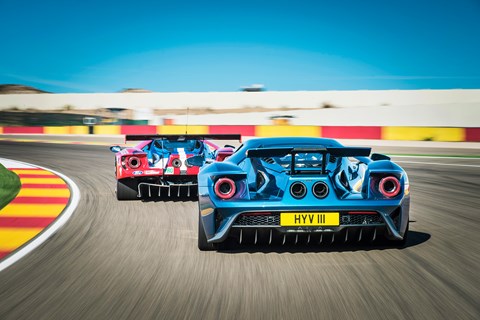
And ideal for us, because one of the two roadgoing Ford GTs currently in Europe is here. To see just how much DNA the road and race car share, we’ve enlisted the services of Andy Priaulx, multiple world touring car champion and now one of the lead drivers in Ford’s World Endurance Championship (WEC) squad. He’ll record a lap in his race car, and in the road car, both from a standing start (Ford, understandably, prefers not to disclose flying-lap test times). It’s not the most scientific of tests, but it’s the same day, same track, same conditions, same driver – good enough to determine if the Ford GT road car really is a Le Mans winner with number plates.
Read our full review of the Ford GT supercar right here
‘The road car is the racing car, and the racing car is the road car,’ Ford Performance boss Dave Pericak told CAR at the GT’s original unveil. He wasn’t joking; seeing the two cars alongside each other at Aragon it’s clear they share more than a badge.
‘It’s almost better to look at what you can’t change when you make a race car from your road car,’ Ford WEC team principal George Howard-Chappell tells me when I ask him how his LM GTE racers differ from their roadgoing counterparts. ‘If you’re a manufacturer, you’re looking for a good donor car. The GT is a really nice shape – low drag, easy-to-get downforce, and the long wheelbase is good for stability. It’s also very light, and easy to make safe. The consideration for making a fantastic supercar was always there – a lot of the same considerations for racing are also advantageous for making a no-holds-barred road car.’
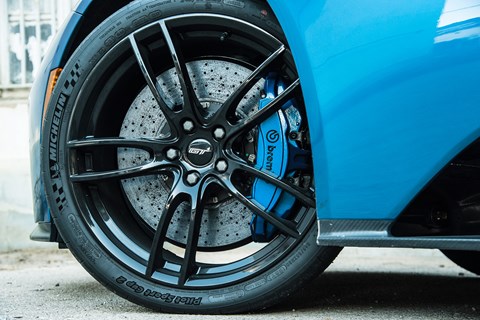
‘Having the opportunity to develop both the road car and the race car together [working with Canadian company Multimatic Engineering] is both good and bad,’ Dave Pericak says. ‘It’s good in that you’re able to design into the road car the things that make a really good race car. The bad part is that basically the same team that’s doing the road car is doing the race car, so it puts a massive strain on that team as you’re trying to manage building the two requirements together. It gave us a significant advantage on the track, but it was a stressful process.’
So, which bits are common to both cars? ‘The basic structure is the same, and about 70 per cent of the shape, along with the crash structure and many other elements,’ Howard-Chappell explains. ‘The engine is a V6 turbo from the same family, but a slightly different one from the road car, allowed by the regulations.’
The road car’s fascinating torsion-bar rocker-arm suspension is still there, albeit with slightly different geometry and components. It’s set at a fixed height, unlike the road car, which can bounce into different ride height positions like a supercar engineered by Snoop Dogg. In Track mode it shuts out one of its two sets of springs and sinks by 50mm, so low you’d swear the tyres will rub on the arches. Operating at double its usual spring rate, it’s set up to behave in a similar way to the racing car.
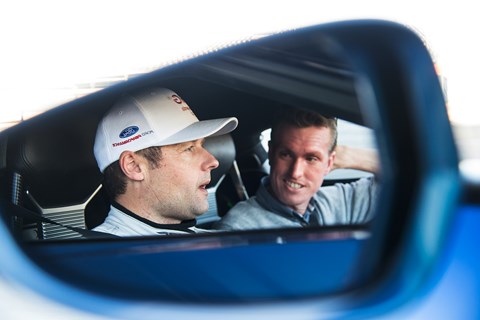
While the road car’s exhausts exit in the middle of its tail, the racer’s lack of cats or silencers enables direct side pipes, their note a flat, white-noise blat that buzzes your eardrums like a hornet in a jar as it streaks past the pitwall to start another testing lap, firing off a rat-tat-tat salvo of downshifts for Turn 1 with a curiously rough overtone. ‘That’s the anti-lag system,’ explains Ford IMSA team driver Richard Westbrook. ‘People tell us it sounds like we’re running traction control under braking but that’s the anti-lag. It makes the engine really driveable.’
Time to find out just how driveable, from the passenger seat. Testing’s concluded for the day, and that leaves us the narrowest of windows to squeeze in a lap with Priaulx in both cars. He’s just finished a double-stint of testing laps, but looks so relaxed as he drops into the driving seat of the road car that he might have been reading the paper and having a cup of tea.
‘This is a great bit of kit,’ he says, thumbing the drive mode wheel and dropping the car into Track mode: minimum suspension movement, maximum downforce from the active rear spoiler. ‘I drove it at the Goodwood Festival of Speed earlier this year – it’s quick.’ This is his first time driving the roadgoing GT properly on a circuit rather than Lord March’s driveway, but you wouldn’t know it; out of the pitlane he’s straight on it, getting a feel for the grip on offer through Aragon’s fast sweepers.
‘Tell you what, this feels like a proper racing car through here,’ he says, as we drop into the plunging Laguna Seca-like Corkscrew section, leading up to the never-ending back straight. The V6 puts its shoulder to it and tractor-beams the horizon. I can read the digital speedo from the passenger seat as the digits click over like a fruit machine – 160, 165, 179mph before the carbon-ceramic brakes wipe off the speed to turn into the final corner at a nice, round 100mph. ‘Are you happy doing 180mph? You’re mad,’ he chuckles. I couldn’t feel less nervous – I’ve total trust in Priaulx, and based on that warm-up lap, in the car too.
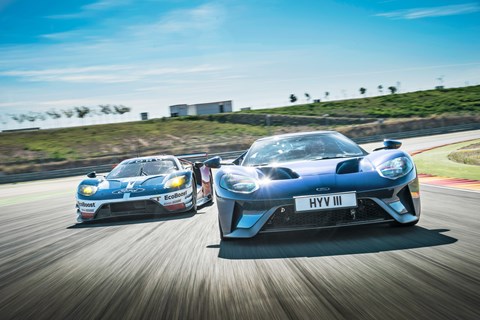
Time for a timed run. Launch control engaged – throttle hits stop, left foot leaves brake pedal, car leaves line, fast. Aragon’s first corner is a tricky left-hander – he brakes late, and we enter at an unfeasibly high speed. As impressive as Priaulx’s driving is the fact that he has the spare mental capacity to commentate at the same time, chatting like a tour guide while driving one of the world’s fastest road cars close to the limit. ‘Amazing brakes – wow. Fantastic balance through Turn 1. Bit of push – rear following nicely – it’s really holding up well under cornering.’
The long, curving opening corners give the GT’s downforce a chance to work, then it’s hard on the brakes for Turn 5, entered in the hint of a four-wheel slide, and exited with a correctional stab of opposite lock – this is a road car that doesn’t understeer. More oversteer, too, through the ultra-quick Parabolica that leads onto the back straight. ‘That’s where the wings of the race car would really help you,’ Priaulx says.
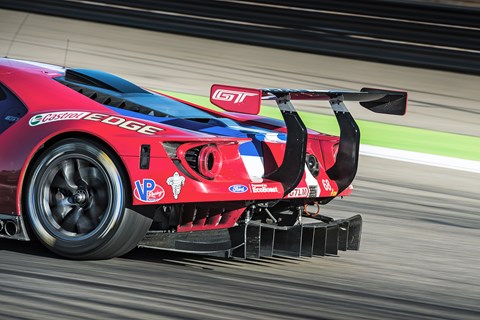
With its rear wing fully extended the road car generates genuine downforce, but it can’t compete with the race car’s ironing-board rear wing and gigantic diffuser hanging way out behind. ‘I think this is going to be faster than my race car down here,’ Priaulx says as we reach the straight; the road car has less drag and an extra 100bhp or so to play with, after all. This time we reach 183mph before hitting the brakes for the final long U-turn – ‘that’s a beautifully balanced race car through there,’ says Andy, approvingly, as we head for the finish line, stopping the clock at 1m 50.25sec.
‘Fast, eh? There’s more lap time left in that,’ he says, short-shifting on the cool-down lap. ‘What I find amazing is the way it loads the front and rear tyres equally; you turn in and it’s just got phenomenal front grip, which is really unusual for a road car – any sports car would normally push the front tyres on track. And it doesn’t roll. The turn-in, you know, the change of direction,’ he says, tweaking the wheel to demonstrate, ‘boom – straight in.’
A few minutes later, he’s set a time in the race car – 1m 40sec, peaking at 180mph. There are plenty of caveats at play here – the race car has a narrow operating window, and was hindered slightly by cold brakes and tyres; the road car had to carry my 65kg of passenger ballast, and Priaulx was driving well within the car’s limits for safety. But for the road car to get within 10 seconds of its Le Mans-conquering brethren, whatever the conditions, is mighty impressive.
‘When we say that we race what we sell, we can honestly say that,’ Pericak says. ‘We are the only GTE LM car that actually has zero waivers, zero exceptions [by which he means no major technical changes to make it competitive]. We’re the only car on track that can make that claim.’
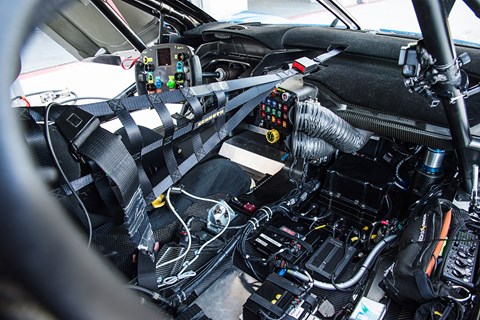
Which brings us onto a three-letter acronym that keeps racing car engineers awake at night: BoP, or Balance of Performance. The Ford GT might have had certain elements purposefully designed into it to make it as fast as possible on track, but it has to race with its proverbial shoelaces tied together, in line with endurance racing’s policy of ensuring its competitors race on as even a footing as possible. In the WEC and the equivalent IMSA series in America, the Ford GT races against everything from Porsche’s 911 RSR (which has one fairly major ‘waiver’ versus its rear-engined road-car cousin – it’s mid-engined) to Corvettes, Ferrari 488s and the BMW M6 – which looks about twice the height of the blade-like GT.
Aston Martin’s old Vantage won the class at Le Mans in 2017 – a wonderful, charismatic road car, but one which wouldn’t see which way a Ford GT had gone without the give-and-take BoP formula, which uses a combination of weight ballast and power restrictions to even out the disparate manufacturers’ cars’ performance. Richard Westbrook explains that, in general, ‘the lower the car’s centre of gravity, the heavier you go. Our car’s very drag-efficient – which makes it very fast at the end of the straight.
But the extra weight hurts us at the start of the straight.’ Looking at the GT’s impossibly low frontal area, with a roofline barely higher than the GT40 of the ’60s, famously named after its height in inches, it’s not surprising to learn it’s required to run as one of the heaviest cars in the field. ‘The race car weighs around 1270kg – about the same as the Ferrari. We’re 90kg heavier than the Aston, and also heavier than the 911 RSR,’ says Howard-Chappell. And where the GT road car summons nearly 640bhp from its twin-turbo V6, the race car’s pegged back to little more than 500bhp.
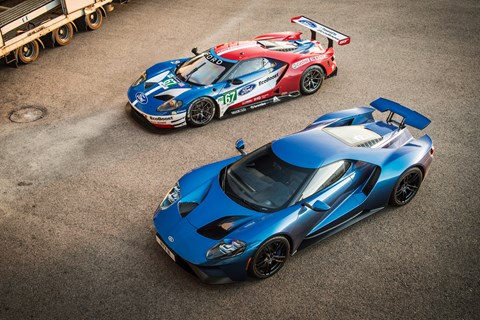
Driving the GT for car-to-car photos, Priaulx’s race car pacing along to my left under the Spanish sunshine and Aragon’s endless straight stretching to the horizon ahead, is a memory that will stay with me for a long time. It’s made all the sweeter by the knowledge that if we both pushed the throttle pedal to the stop at the same time, the road car would probably make it to the horizon first…
But what about on the road?
It’s the morning after the tyre test, sun yet to rise. The race team’s packed up and the road car will be transported back to the UK in a few hours’ time, but right now it’s idling in the pre-dawn gloom, warming its fluids, driver’s door aloft. We’ve established it’s shot through with race car DNA, but we have to explore the road car bit. Is the GT just too track-focused for its own good?
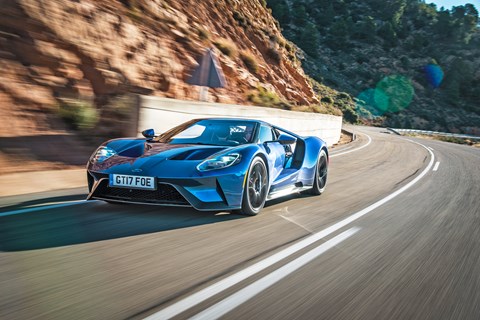
Slide over the wide carbon sills and you’re left in no doubt that you’re deep within the structure of the car. There’s carbon everywhere; even the dash is a structural element. Its design is functional to the point of being nondescript, the steering wheel an ugly switchgear-peppered oblong.
It feels great on the move, the power steering (linked to the same hydraulic system as the moveable wing and suspension) purposefully weighty and unerringly accurate. There’s similarly brilliant feel and feedback through the brakes, the carbon-ceramic discs more feelsome and less grabby than most, although they ssshhh when you breathe on the pedal, like cupping a seashell to your ear.
The rest of the car’s pretty vocal too, a cacophony of creaks, squeaks and rattles accompanied by whooshes and whistles from the turbos. You’ll need to talk pretty loudly to chat with your passenger, assuming they haven’t been scared into silence. The central pipes sound more nuanced than the race car’s, the V6 emitting a nice throaty tone, even if it doesn’t quite set your hairs on end like a Lamborghini.
Throttle response does, though, the merest twitch of your big toe registering on the digital rev counter, turbo lag conspicuous by its absence. And no question it’s powerful; on decidedly dog-eared tyres from the previous day’s track activities, the traction control light is still winking in fifth gear… And yet it’s not scary. As we travel further from Aragon, the road untangles into long, fast, freehand arcs and the GT feels planted, its long wheelbase and all that wind tunnel work instilling huge stability, and in turn confidence.

Ride quality is on the firm side, even in Comfort mode, but there is fluidity to the GT’s movements – it doesn’t feel like a solidly sprung racetrack refugee. It looks a bit like one in places, though – there’s sealant visible between the A-pillars and windscreen, for instance, the boot’s laughably tiny and there’s nowhere to put anything in the interior. The seat bases are fixed in position, while you heave on a strap to move the pedals instead – it’s lighter that way round. Back rests do adjust, though, and I actually found them incredibly comfortable over a few hours’ driving. They look great too, curved ripples of leather like a ’60s sports car. Rear visibility? Not so much. But thanks to its clear reversing camera, the GT’s no more or less difficult to reverse than most supercars.
Natural rivals are hard to pinpoint. The GT occupies its own space in the supercar kingdom; more focused than an Aventador SV, more exotic than a 911 GT2 RS. Radical’s RXC Coupe was also designed with dual road/race roles (and uses the same Ford EcoBoost V6) but that’s hairier still. Perhaps closest is the Glickenhaus SCG Stradale, but that was designed as a race car first, then adapted for road use. The McLaren 720S is more rounded but it’s a different animal.
Ford could have made another retro pastiche of the original GT40, and it would have sold. But it chose not to. The racing link gives this car a credibility that, for me, makes it the most compelling supercar on sale today. That the GT can fight for victory at Le Mans and play the role of thrilling road toy is remarkable, and cements its status as a stand-out achievement in the same vein as the original GT40.
Check out our Ford reviews
